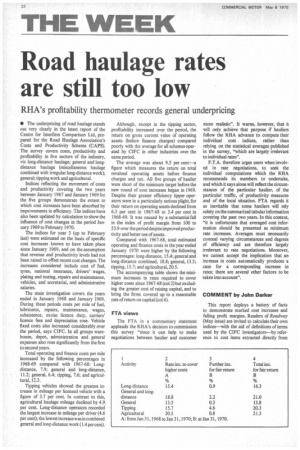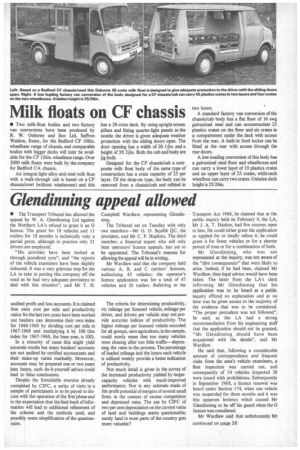Road haulage rates are still too low
Page 24

Page 25

If you've noticed an error in this article please click here to report it so we can fix it.
RHA's profitability thermometer records general underpricing
• The underpricing of road haulage stands out very clearly in the latest report of the Centre for Interfirm Comparison Ltd, prepared for the Road Haulage Association's Costs and Productivity Scheme (CAPS). The survey covers costs, productivity and profitability in five sectors of the industry, viz long-distance haulage; general and longdistance haulage (miscellaneous haulage combined with irregular long-distance work); general; tipping work and agricultural.
Indices reflecting the movement of costs and productivity covering the two years between January 1967 and January 1969 for the five groups demonstrate the extent to which cost increases have been absorbed by improvements in efficiency. The indices have also been updated by calculation to show the influence of cost changes in the period January 1969 to February 1970.
The indices for year 3 (up to February last) were estimated on the basis of specific cost increases known to have taken place since January 1969, and on the assumption that revenue and productivity levels had not been raised to offset recent cost changes. The increases considered include cost of fuel, tyres, national insurance, drivers' wages, plating and testing, repairs and maintenance, vehicles, and secretarial, and administrative salaries.
The main investigation covers the years ended in January 1968 and January 1969. During these periods costs per mile of fuel, lubricants, repairs, maintenance, wages, subsistence, excise licence duty, carriers' licence fees and depreciation rose. Vehicle fixed costs also increased considerably over the period, says CIFC. In all groups warehouse, depot, administration and general expenses also rose significantly from the first to second years.
Total operating and finance costs per mile increased by the following percentages in 1968-69 compared with 1967-68: Longdistance, 7.9; general and long-distance, 11.2; general, 6.4; tipping, 7.6; and agricultural, 12.3.
Tipping vehicles showed the greatest increase in mileage per licensed vehicle with a figure of 3.7 per cent. In contrast to this, agricultural haulage mileage declined by 4.9, per cent. Long-distance operators recorded the largest increase in mileage per driver (4.6 per cent); the lowest increase was in combined general and long-distance work (1.4 per cent). Although, except in the tipping sector, profitability increased over the period, the return on gross current value of operating assets (before finance charges) compared poorly with the average for all schemes operated by CIFC in other industries over the same period.
The average was about 9.5 per cent-a figure which measures the return on total revalued operating assets before finance charges and tax. All five groups of haulier were short of the minimum target before the new round of cost increases began in 1969.
Despite their greater efficiency tipper operators were in a particularly serious plight, for their return on operating assets declined from 6.3 per cent in 1967-68 to 3.4 per cent in 1968-69. It was caused by a substantial fall in the index of profit margin from 100 to 53.9 over the period despite improved productivity and better use of assets.
Compared with 1967-68, total estimated operating and finance costs in the year ended January 1970 were higher by the following percentages: long-distance, 15.4; general and long-distance combined, 18.8; general, 13.5; tipping, 15.7; and agricultural, 20.5.
The accompanying table shows the minimum increases in rates required to cover higher costs since 1967-68 (col 2) but excluding the greater cost of raising capital, and to bring the firms covered up to a reasonable rate of return on capital (col 4).
FTA views The FTA in a commentary statement applauds the RHA's decision to commission this survey "since it can help to make negotiations between haulier and customer more realistic". It warns, however, that it will only achieve that purpose if hauliers follow the RHA advance to compute their individual cost indices, rather than relying on the statistical averages published in the survey, "which are largely irrelevant to individual rates".
E.T.A. therefore urges users when involved in rate negotiations, to seek the individual computations which the RHA recommends its members to undertake, and which it says alone will reflect the circumstances of the particular haulier, of the particular traffic, of productivity measures and of the local situation. FTA regards it as inevitable that some hauliers will rely solely on the summarized tabular information covering the past two years. In this context, "it is unfortunate that averaged cost information should be presented as minimum rate increases. Averages must necessarily conceal varying circumstances and degrees of efficiency and are therefore largely irrelevant to rate negotiations. Moreover, we cannot accept the implication that an increase in costs automatically produces a case for a corresponding increase in rates; there are several other factors to be taken into account".
COMMENT by John Darker
This report deploys a battery of facts to demonstrate marked cost increases and falling profit margins. Readers of Roadway (May issue) are invited to calculate their own indices-with the aid of definitions of terms used by the CIFC investigators-by reference to cost items extracted directly from
audited profit and loss accounts. It is claimed that once cost per mile and productivity ratios for the last two years have been worked out hauliers can determine their own index for 1968-1969 by dividing cost per mile in 1967-1968 and multiplying it by 100 (the index for 1967-1968, the base year, is 100).
In a minority of cases this might yield accurate results but many hauliers' accounts are not audited by certified accountants and their make-up varies markedly. Moreover, accounts may be prepared one or two years late; hence, such do-it-yourself advice could lead to false conclusions.
Despite the formidable exercise already completed by CIFC, a series of visits to a sample of participants is to be payed to discuss with the operation of the first phase and in the expectation that the feed-back of information will lead to additional refinement of the scheme and the methods used, and possibly some simplification of the questionnaire. The criteria for determining productivity, viz mileage per licensed vehicle, mileage per driver, and drivers per vehicle may not provide accurate indices of productivity. The higher mileage per licensed vehicle recorded for all groups, save agriculture, in the sample, could surely mean that too many vehicles were chasing after too little traffic—depressing the rates in the process. The percentage of loaded mileage and the hours each vehicle is utilized weekly provide a better indication of productivity.
Not much detail is given in the survey of the increased productivity yielded by largercapacity vehicles with much-improved performance. Nor is any estimate made of the profit potential of mergers of several small firms in the context of excess competition. and depressed. rates. The use by CIFC of two per cent depreciation on the current valne of land and buildings seems questionable; surely land in most parts of the country gets more valuable?
















































































































